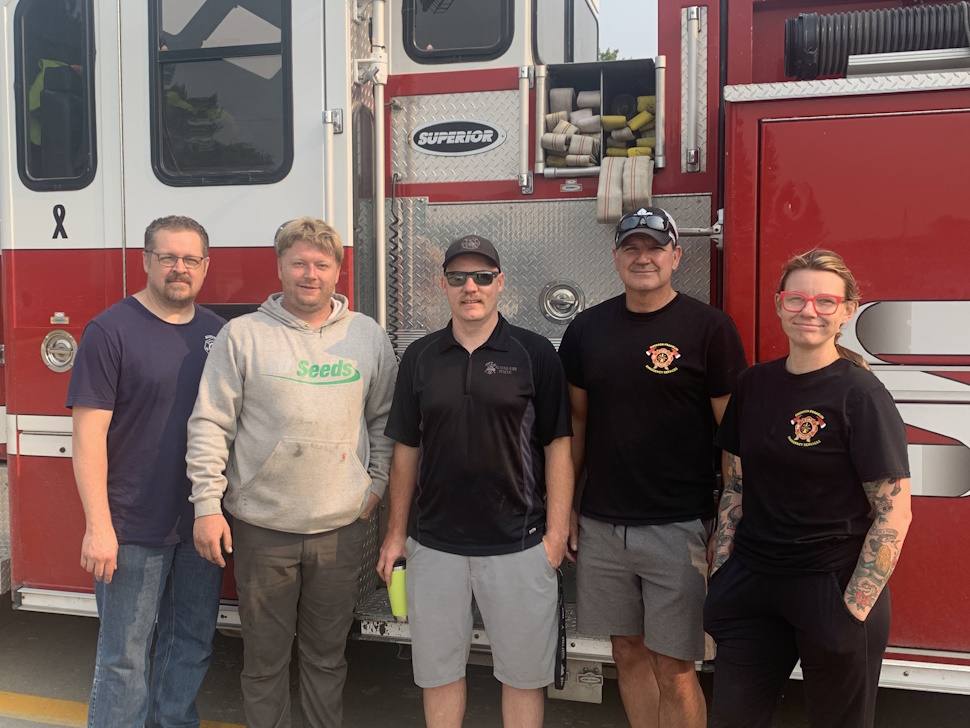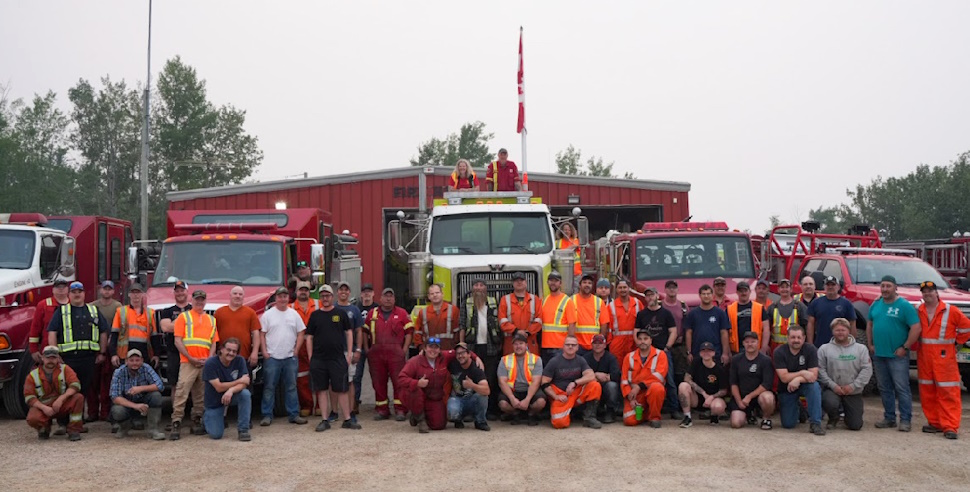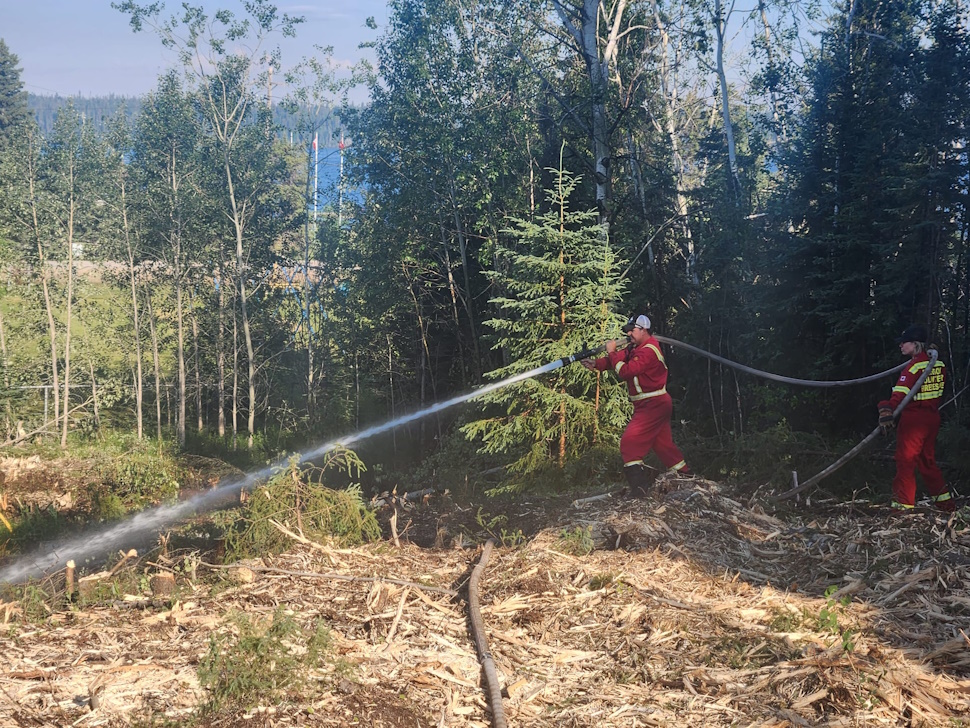A local volunteer firefighter is doing his part to support those on the front lines of Manitoba’s wildfire response.
The town of Snow Lake was evacuated on July 10 due to the threat of wildfires. Just two days later, on July 12, volunteer firefighter Steve Slaney from Dominion City joined crews to assist with wildfire protection. They returned one week later, on July 19.
Slaney was part of a five-person crew that included three members from Altona Rhineland Emergency Services (ARES) and one other firefighter from the Emerson-Franklin department.

Dave Fehr, Steven Stoesz, and Steve Nuefeld from ARES and Steve Slaney and Amber Lynn Knutt from Emerson-Franklin. (Left to right)
He says their team was responsible for providing fire protection around the community of Snow Lake.
“There were crews that were set up both in town and outside of town at their two mining sites. Of course, that's their livelihood up there. So, a lot of fire protection, sprinklers, going around protecting hydro poles, cutting down trees and wetting that stuff down as best as possible.”

Morden Fire Department tanker sprays trees to lower the risk of catching fire.
He adds that local fire crews and mine workers were stationed around the mine sites because they knew the area well, and especially since there is only one road in and out.
Communication and support
Slaney says the emergency response was well-coordinated, with clear communication. He notes that a mine safety organization and the local fire department played key roles in guiding crews on what to do and where to go.
“They had us all register, and we would all communicate through WhatsApp. So, we were getting messages from everybody and that way, each of the teams had to tell where they were and how many were with them at all times for accountability purposes. And that way, if anybody were in trouble, people would be able to get to them as soon as possible, or of course, any other immediate dangers, people would be aware, and then they work together.”
Slaney explains that the day crew worked from 8 a.m. to 8 p.m., followed by a night crew taking over for their 12-hour shift. At each shift change, they held a meeting to share updates on the status of the fires.
The crews were accommodated in hotels and provided with meals throughout their stay.
“They fed us well. Three meals a day, breakfast, lunch, and dinner. It was amazing, they took real good care of us. They were very appreciative of having us there.”
An eye-opening experience
Slaney says that only fire trucks and essential workers were present and describes it as a strange experience to see the town completely evacuated.
“It was definitely eerie not seeing any civilians around, and it put in perspective (because) you didn't feel like you were doing too much, just spraying water on things, but someone had mentioned that this town has been evacuated. There are only certain people allowed in this town, and they said we're some of those certain people. So, it makes you put it in perspective, then it's like, yeah, so what we're doing is probably pretty important.”
Another frightening aspect was that there were two major fires, one to the northeast of the town and the other to the southwest, while only a single road connected Snow Lake to the highway.
“They had mentioned if we do come to a situation where the fire is getting closer, all of those people would be immediately evacuated, and then there would be us left. And then, if need be, if the highway were to get blocked off, they had helicopters available to evacuate us if it became too overwhelming.”
Slaney adds that some days initially seemed manageable, but conditions could change suddenly and become much worse.
“There were a lot of days where there were clear skies and sunny, and you would never think that there was a fire around. But then other days, depending on the wind and the situation, the smoke would roll in, and you're like, ‘Ok, we're back into it again here’. But they just made sure that we were aware of what we were getting into and explaining to us what would happen if things turned bad quickly.”
Answering the call to help
Slaney says when the Pembina Valley Mutual Aid District met with local fire chiefs looking for volunteers, he raised his hand.
“It was our Deputy Chief Shawn and Jeff French that let me know, asked if anybody would be interested. Obviously, being a teacher, I have some time available right now, and I figured, you know what, for sure I would love to go up there and help.”
Although it was frightening at times, Slaney says the experience was worth it.
“That was my first time, of course, and if the opportunity may present itself again, I would definitely look at doing it again in the future. When you saw how appreciative the people were there for us being there and helping, that definitely makes it worthwhile right there.”
Teamwork on the front lines
Alongside Manitoba firefighters, including teams from Flin Flon, specialized wildfire crews known as “hotshots” were also present.
“There was actually a crew there from Mexico and Australia when we were there. So, there are people from all over the world up there helping out.”
Slaney adds that the Emerson-Franklin Fire Department has since sent a second crew up north, and they are expected to return on Thursday, July 24.

Snow Lake fire protection crew.
